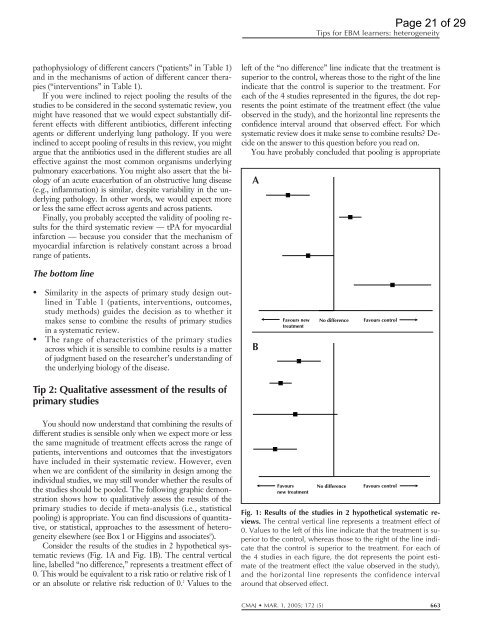Tips for Learners of Evidence-Based Medicine
Tips for Learners of Evidence-Based Medicine
Tips for Learners of Evidence-Based Medicine
Create successful ePaper yourself
Turn your PDF publications into a flip-book with our unique Google optimized e-Paper software.
pathophysiology <strong>of</strong> different cancers (“patients” in Table 1)<br />
and in the mechanisms <strong>of</strong> action <strong>of</strong> different cancer therapies<br />
(“interventions” in Table 1).<br />
If you were inclined to reject pooling the results <strong>of</strong> the<br />
studies to be considered in the second systematic review, you<br />
might have reasoned that we would expect substantially different<br />
effects with different antibiotics, different infecting<br />
agents or different underlying lung pathology. If you were<br />
inclined to accept pooling <strong>of</strong> results in this review, you might<br />
argue that the antibiotics used in the different studies are all<br />
effective against the most common organisms underlying<br />
pulmonary exacerbations. You might also assert that the biology<br />
<strong>of</strong> an acute exacerbation <strong>of</strong> an obstructive lung disease<br />
(e.g., inflammation) is similar, despite variability in the underlying<br />
pathology. In other words, we would expect more<br />
or less the same effect across agents and across patients.<br />
Finally, you probably accepted the validity <strong>of</strong> pooling results<br />
<strong>for</strong> the third systematic review — tPA <strong>for</strong> myocardial<br />
infarction — because you consider that the mechanism <strong>of</strong><br />
myocardial infarction is relatively constant across a broad<br />
range <strong>of</strong> patients.<br />
The bottom line<br />
• Similarity in the aspects <strong>of</strong> primary study design outlined<br />
in Table 1 (patients, interventions, outcomes,<br />
study methods) guides the decision as to whether it<br />
makes sense to combine the results <strong>of</strong> primary studies<br />
in a systematic review.<br />
• The range <strong>of</strong> characteristics <strong>of</strong> the primary studies<br />
across which it is sensible to combine results is a matter<br />
<strong>of</strong> judgment based on the researcher’s understanding <strong>of</strong><br />
the underlying biology <strong>of</strong> the disease.<br />
Tip 2: Qualitative assessment <strong>of</strong> the results <strong>of</strong><br />
primary studies<br />
You should now understand that combining the results <strong>of</strong><br />
different studies is sensible only when we expect more or less<br />
the same magnitude <strong>of</strong> treatment effects across the range <strong>of</strong><br />
patients, interventions and outcomes that the investigators<br />
have included in their systematic review. However, even<br />
when we are confident <strong>of</strong> the similarity in design among the<br />
individual studies, we may still wonder whether the results <strong>of</strong><br />
the studies should be pooled. The following graphic demonstration<br />
shows how to qualitatively assess the results <strong>of</strong> the<br />
primary studies to decide if meta-analysis (i.e., statistical<br />
pooling) is appropriate. You can find discussions <strong>of</strong> quantitative,<br />
or statistical, approaches to the assessment <strong>of</strong> heterogeneity<br />
elsewhere (see Box 1 or Higgins and associates 9 ).<br />
Consider the results <strong>of</strong> the studies in 2 hypothetical systematic<br />
reviews (Fig. 1A and Fig. 1B). The central vertical<br />
line, labelled “no difference,” represents a treatment effect <strong>of</strong><br />
0. This would be equivalent to a risk ratio or relative risk <strong>of</strong> 1<br />
or an absolute or relative risk reduction <strong>of</strong> 0. 2 Values to the<br />
<strong>Tips</strong> <strong>for</strong> EBM learners: heterogeneity<br />
left <strong>of</strong> the “no difference” line indicate that the treatment is<br />
superior to the control, whereas those to the right <strong>of</strong> the line<br />
indicate that the control is superior to the treatment. For<br />
each <strong>of</strong> the 4 studies represented in the figures, the dot represents<br />
the point estimate <strong>of</strong> the treatment effect (the value<br />
observed in the study), and the horizontal line represents the<br />
confidence interval around that observed effect. For which<br />
systematic review does it make sense to combine results? Decide<br />
on the answer to this question be<strong>for</strong>e you read on.<br />
You have probably concluded that pooling is appropriate<br />
A<br />
B<br />
Favours new<br />
treatment<br />
Favours<br />
new treatment<br />
No difference<br />
No difference<br />
Favours control<br />
Favours control<br />
Page 21 <strong>of</strong> 29<br />
Fig. 1: Results <strong>of</strong> the studies in 2 hypothetical systematic reviews.<br />
The central vertical line represents a treatment effect <strong>of</strong><br />
0. Values to the left <strong>of</strong> this line indicate that the treatment is superior<br />
to the control, whereas those to the right <strong>of</strong> the line indicate<br />
that the control is superior to the treatment. For each <strong>of</strong><br />
the 4 studies in each figure, the dot represents the point estimate<br />
<strong>of</strong> the treatment effect (the value observed in the study),<br />
and the horizontal line represents the confidence interval<br />
around that observed effect.<br />
CMAJ MAR. 1, 2005; 172 (5) 663
















